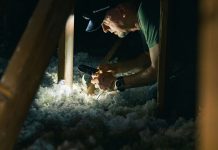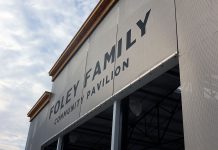The Windsor Town Council will hold a public hearing on one item and consider action on four items at its upcoming Sept. 1 meeting.
Surveillance cameras on the Town Green
City staff and Windsor Police Chief Mike Raasch support installing surveillance cameras on the Town Green. Should the council authorize the staff to pursue a concept for installation?
The staff report states that opponents to surveillance equipment in public space say that individuals should have the expectation they are not being watched by law enforcement while in public. Other concerns against surveillance cameras include the possibility that surveillance data can be hacked or misused.
While the town is only prohibited by the United States Constitution from installing surveillance equipment in private spaces without consent or a warrant, it is legal to install cameras recording video without audio in public spaces like the Town Green.
“Public cameras are being installed more frequently throughout cities and towns across the nation. While cameras do not stop all crime, they are a deterrent and can be used as a good supplement to police patrol efforts. Cameras can capture and record activity at a park that might later be useful if a crime is reported there, providing an evidentiary item to do immediate follow-up on. They have been described as ‘unbiased, independent eyes that record real-time information,’” the staff report reads.
If council agrees with the idea of installing surveillance cameras on the Town Green, staff would return with policies and regulations addressing privacy and how footage would be stored, retained and access.
Installation of a multi-camera surveillance system on the Town Green would cost approximately $25,373 in installation costs, with minimal ongoing maintenance costs expected.
Fire impact fee
A new fire impact fee could be applied to future developments to help fund the Sonoma County Fire District (SCFD). The Windsor Town Council will hold a public hearing regarding the adoption of the fee within the district’s boundaries, including Windsor.
The district formally requested the Windsor Town Council adopt such a fee in October 2020 to help cover the one-time cost of expanding the District’s facilities, apparatus and equipment in order to maintain the currently provided level of service
SCFD was established in 2019 by consolidating the Windsor Fire District, two Santa Rosa fire districts and the Mountain Volunteer Fire Department. In 2020 and 2021, SCFD expanded to include fire protection districts operating in Guerneville and Forestville. Currently, SCFD operates 10 fire stations, two of which are in Windsor.
The new fee program is considered by the staff report to be an improvement on the existing fee program, which it identifies as outdated and inadequate to cover the true costs of Windsor’s fire impacts.
Homelessness governance
The Town Council will select a council member to participate in a countywide governmental effort to address issues of homeless in Sonoma County.
In 2018, the Sonoma County Continuum of Care (CoC), the county’s agency tasked with issues regarding homeless as required by the Federal Department of Housing and Urban Development (HUD), formed the Home Sonoma County Leadership Council made up of five representatives (two county supervisors, two Santa Rosa council members, and one council member from Petaluma).
This board, which was criticized for not including representation from medium and small cities, was dissolved in 2020, and, following its dissolution, most of the cities in Sonoma County formed a group with one council member selected per city to engage collectively and with the county on homelessness issues.
Each of the other cities involved has selected a representative, and Windsor’s selected council member will work with their cohort on six identified priorities by (see page 2 of the agenda report).
“The group provides a unified voice of city elected leaders, which is a more effective approach than addressing these issues one city at a time. This also supports the regional approach necessary to address homelessness successfully,” the agenda report reads.
Water reclamation facility phosphorous elimination improvements
The council will consider city staff’s recommendation to enter into two agreements with private companies to pursue the construction of an Aerobic Granular Sludge (AGS) system at the town’s Water Reclamation Facility (WRF). The companies with which the town would contract are Black& Veatch Corporation, at an amount not to exceed $166,000, and Aqua-Aerobics System, Inc., at an amount not to exceed $180,000, for a total amount not to exceed $346,000.
Per its North Coast Regional Water Quality Control Board permit, the WRF is required to eliminate or offset all phosphorous discharge by Oct. 1 2023. WRF currently uses aeration basins to help biodegrade waste and reach permissible levels of certain chemicals like ammonia. Aeration basins do not reduce phosphorous levels enough to satisfy the new regulations, and with the credit markets for phosphorous offset not yet established, the Town of Windsor launched a study in 2019 that found modernizing WRF’s two aeration basins to reach phosphorous elimination requirement would cost $20 million.
The agreements proposed by staff would set up a six-month pilot program renting an AGS system, and would provide a substantially cheaper option to meet phosphorous elimination requirements.
More information requested on “The Oaks” development
Staff is seeking direction on the conceptual project plans and potential amendments to a 33-unit residential project called “The Oaks.”
The project was initially begun in 2005 as a 15-unit condominium project called “Town Green Village 7,” however, it was abandoned due to economic difficulties following the installation of utilities, parking spaces, curbs and gutters.
The project was resurrected as “The Oaks” in 2019, which would have been a 31-unit flat- and townhome-style residential project, before being sold on an 18-month option to current developer, Doyle Heaton of Falcon Point Associates. In its current iteration, the project will contain a mix of single-family dwelling types and up to nine live/work units, all on small lots. Four units would be deed-restricted affordable housing for moderate-income families.
Earlier this month, the Windsor Planning Commission was unable to provide direction to Council regarding the project’s architecture, requiring more detailed information.
Topics of discussion for the project will include accessory dwelling units (ADUs), parking, development standards (for the project’s small-lot single-family detached units, three-story units along Old Redwood Highway, zero-foot side yard setbacks for duet units, rear setbacks, live/work units) and site plan and design review.









